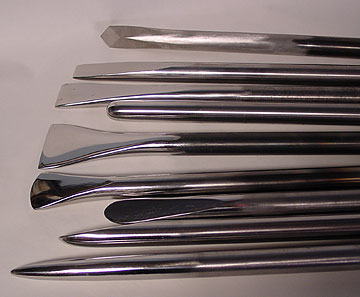The majority of the metal spinning tools in my collection were made somewhere between 1900 and 1920. To the best of my knowledge Delta, Boice-Crane, Powermatic, and Yates-American were the last known manufacturers of quality traditional style metal spinning tools. None of these companies seems to have continued making them after the 1960's. In the late 1990's the Sorby company of England introduced a selection of light weight spinning tools which were not really heavy enough for most serious spinning work.
To fill this void, I decided to manufacture my own line of hand forged and hardened metal spinning tools. These tools have been designed based upon many of the ancient traditional tools in my collection and based upon my own experiences spinning metal. Below I shall briefly demonstrate the method of manufacturing these tools.
The forging process:
All of the traditional style of metal spinning tools that I manufacture are made of hand forged high carbon tool steel - just as they used to be made. The tools start out as a bar of tool steel which is heated in my forge..........
......... then allowed to slowly cool overnight by placing the heated ends into a container of insulating material. This image shows four tools being annealed.
After annealing, the tools are heated up to forging temperature. I usually work on two tools at a time. This allows one to be heating as I am forging the other. The tools shown at the left are a "diamond tool" and a "planishing tool". They are shown here with the forging almost completed. Their rough shapes can easily be seen.
The heated tools are shaped with a hammer on my blacksmith's anvil. Here you can see me in the process of forging a planishing tool. It will take several trips from the forge to anvil and back before the desired shape is attained. After this shaping, the tools are again annealed in the insulation pail to remove strains.
At the left are shown four types of spinning tools after the forging and annealing processes. From left to right are: skimmer, diamond, planisher, and point tools. These tools are shown in the rough forged shape. The next step will be to rough grind them to the finished desired shape.
The image at the right clearly demonstrates the differences between the raw forged surfaces and the rough ground surfaces.
The image at the left illustrates the same four tools after the rough grinding process. The finished shapes for the tools are now very apparent.
The next steps will be to harden, temper, finish grind and polish as needed.

Here is shown a selection of finished hand forged metal spinning tools. This does not illustrate every tool needed for spinning; but, rather, an assortment of some popular styles.